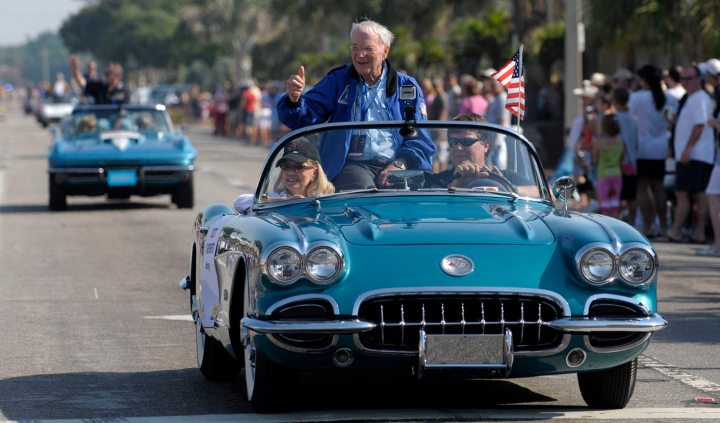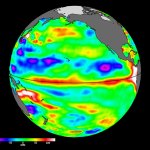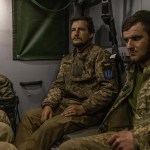Newsdeck
Astronaut Scott Carpenter, 4th American in space, dies At 88

Astronaut Scott Carpenter, who in 1962 became the fourth American in space and the second to orbit the Earth, died on Thursday in Colorado at age 88 of complications from a stroke, his wife Patty Carpenter said. By Alex Dobuzinskis and Bill Trott.
Carpenter, who lost radio contact with NASA controllers during his pioneering space flight and was found in the ocean 250 miles from the targeted splashdown site, went on to explore the ocean floor in later years. His wife said he died in a Denver hospice.
The National Aeronautics and Space Administration chose Carpenter and six other pilots to be astronauts in 1959 for the Mercury space program as the United States entered its space race with the Soviet Union. The only surviving member of that Mercury 7 team is John Glenn, 92, now a retired U.S. Senator from Ohio. In 1962, Glenn became the first American to orbit the earth, and Carpenter was his backup on that mission.
Later that year, Carpenter made his only spaceflight, taking the Aurora 7 spacecraft on three laps around Earth on May 24, a few weeks after his 37th birthday. The flight of less than five hours made him the second American to orbit Earth.
The other Mercury astronauts had piloted fighter jets during the Korean War, but Carpenter mostly flew surveillance in multi-engine propeller planes.
“Scott was the only one with a touch of the poet about him in the sense that the idea of going into space stirred his imagination,” Tom Wolfe wrote in “The Right Stuff,” his best-selling book about the first astronauts.
A former gymnast known among colleagues for his fitness, Carpenter trained as Glenn’s backup for NASA’s first orbital flight. When Glenn blasted off on the Friendship 7 mission on Feb. 20, 1962, Carpenter sent him off with a simple yet poignant radio transmission: “Godspeed, John Glenn.”
Despite his fame as an astronaut, Carpenter spent considerably more time on the ocean floor than he did in outer space. In 1965, the astronaut became an aquanaut as part of the Navy’s SEALAB II project, spending 30 days living and working at a depth of 204 feet (62 meters) off the California coast.
Born in Boulder, Colorado, he split his time between Vail, Colorado, and West Palm Beach, Florida, Patty Carpenter said. His given name was Malcolm Scott Carpenter but he used Scott as a first name.
DRAMATIC RE-ENTRY
Carpenter’s space flight ran into problems upon re-entry to Earth’s atmosphere, raising questions about whether he would make it back alive. His spacecraft had used too much fuel after he forgot to shut off one of the fuel systems.
After Carpenter fired the retrorockets to power his return, NASA controllers lost radio contact and feared a tragedy.
Aerial search teams eventually spotted Carpenter and the bobbing Mercury capsule – doing fine despite having ended up about 250 miles (400 km) off the splashdown target in the Atlantic.
When President John F. Kennedy called to congratulate him, Carpenter offered his “apologies for not having aimed a little better on re-entry.”
Carpenter became the first American to eat solid food in space, a breakthrough since scientists were not sure how the digestive process would work in zero gravity. He dined on chocolate, figs, dates and cereal that had been compressed into cubes. He told mission control it tasted fine but left crumbs floating throughout his space capsule.
Since so little was known about spaceflight at the time, Carpenter’s mission included relatively simple jobs such as releasing signal balloons, photographing clouds and observing flares fired from Earth.
He discovered that what Glenn had described as looking like “fireflies” around the capsule actually were illuminated ice particles formed by water vapor being vented into space.
“The most important driver in everything we did then was curiosity,” Carpenter told the Orange County Register in 2009. “It’s revelatory. Addictive. Beautiful beyond description. To have been in space is very satisfying of one’s curiosity. It’s instructive. It’s marvelous.”
LIFE UNDER THE SEA
The sea also piqued Carpenter’s curiosity. He was an experienced diver and during his time in SEALAB, part of the Navy’s underwater habitat program, he helped test tools, salvage methods and use of a dolphin to transport supplies from the surface to the lab.
“The sea is a more hostile environment than space,” Carpenter told Time magazine after his SEALAB experience.
Carpenter badly injured his left arm in a 1964 motorcycle accident, leaving the limb with limited range, which ruled him out of future spaceflights.
He returned to NASA two years after his SEALAB mission and helped design the Apollo program’s lunar module that landed on the moon in 1969. He retired from NASA in 1967 and left the Navy in 1969.
Carpenter’s love of the ocean led to work with renowned French oceanographer Jacques Cousteau, whom Carpenter considered a hero. He also wrote two novels described as “underwater techno-thrillers.”
Carpenter was married four times and had seven children, according to “For Spacious Skies,” the autobiography he wrote with his daughter, Kris Stoever. DM
Photo: Astronaut Scott Carpenter waves to well-wishers during a parade commemorating the historic flight of fellow astronaut and space pioneer Alan Shepard, the first American to travel into outer space exactly 50 years ago, May 7, 2011 in Cocoa Beach, Florida. Shepard brought along his 1957 Corvette when he reported for Space Program training in April 1959, and would own at least 10 Corvettes in his lifetime. REUTERS/Phelan Ebenhack-Chevrolet/Handout




















 Become an Insider
Become an Insider